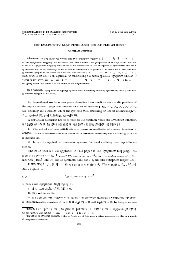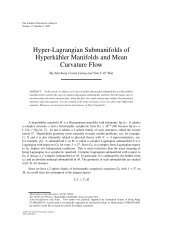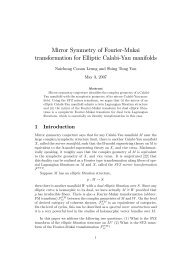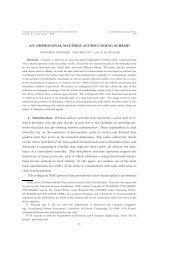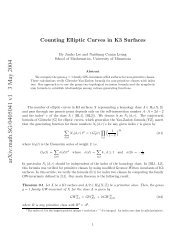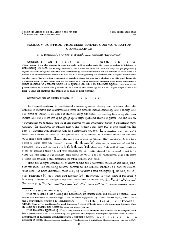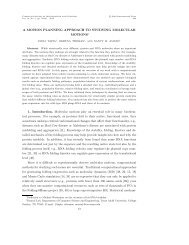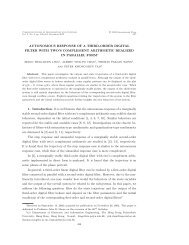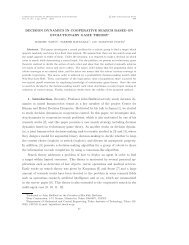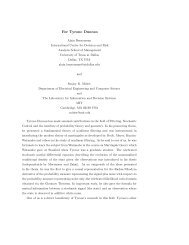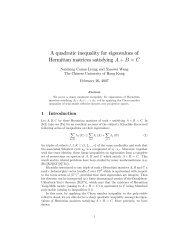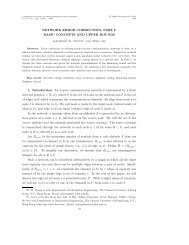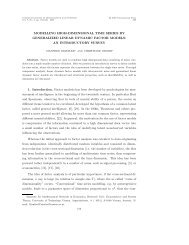AN OPTIMAL DISTRIBUTED ROUTING ALGORITHM USING DUAL ...
AN OPTIMAL DISTRIBUTED ROUTING ALGORITHM USING DUAL ...
AN OPTIMAL DISTRIBUTED ROUTING ALGORITHM USING DUAL ...
Create successful ePaper yourself
Turn your PDF publications into a flip-book with our unique Google optimized e-Paper software.
292 PUNYASLOK PURKAYASTHA <strong>AN</strong>D JOHN S. BARAS<br />
Γ is positive, because each of the terms in the minimum above is positive under our<br />
assumptions. Consequently, we can write<br />
(<br />
(N − 1) dF 1 ∗ (β)<br />
[D(F1 ∗ (β), C 1 )] β + β .F1 ∗ (β) .[D(F1 ∗ (β), C 1 )] β .<br />
dβ<br />
dD(F ∗ 1 ,C1)<br />
dF ∗ 1<br />
D(F ∗ 1 (β), C 1)<br />
(27) + (N − 1)F1 ∗ (β) .[D(F1 ∗ (β), C 1 )] β . log D(F1 ∗ (β), C 1 )<br />
(<br />
)<br />
dF2 ∗ ≥ Γ<br />
(β) + · · · + dF N ∗ (β) N∑<br />
+ Fi ∗ (β) .[D(Fi ∗ (β), C i )] β . log D(Fi ∗ (β), C i ).<br />
dβ dβ<br />
i=2<br />
Using equation (24) and transposing terms we obtain<br />
(28)<br />
≥<br />
(<br />
dF1 ∗ (β)<br />
(N − 1)[D(F1 ∗ (β), C 1 )] β + β .(N − 1) .F1 ∗ (β) .<br />
dβ<br />
dD(F ∗ 1 ,C1) )<br />
[D(F1 ∗ (β), C 1)] β dF1<br />
.<br />
∗ D(F1 ∗(β), C 1) + Γ<br />
N∑<br />
i=2<br />
Fi ∗<br />
∗<br />
(β) .[D(Fi (β), C i)] β . log D(F i ∗(β),<br />
C i)<br />
D(F1 ∗(β), C 1) .<br />
We observe now that the coefficient of dF ∗ 1 (β)<br />
dβ<br />
on the left hand side of the inequality<br />
is positive. Also, using the fact that F1 ∗(β)[D(F 1 ∗(β), C 1)] β = · · · = FN ∗ (β)[D(F N ∗ (β),<br />
C N )] β the expression on the right hand side can be written as<br />
F ∗ 1 (β) .[D(F ∗ 1 (β), C 1)] β .<br />
N∑<br />
i=2<br />
log D(F ∗<br />
i (β), C i)<br />
D(F ∗ 1 (β), C 1) ,<br />
and then using the relation (23), we have the desired result, dF ∗ 1 (β)<br />
dβ<br />
> 0.<br />
Thus, we can conclude that as β ≥ 0 increases, more and more flow is diverted<br />
towards the outgoing links with more capacity, which shows that β can be seen as a<br />
tuning parameter that can be used to change the overall optimal flow pattern in the<br />
network. Increasing β tends to make the flows more concentrated on links lying on<br />
higher capacity paths, and decreasing β tends to make the flows more ‘spread out’ or<br />
‘uniformly distributed’ on the paths (for instance, when β = 0, for the N parallel paths<br />
example, the outgoing flows on all the paths are equal: F ∗ 1 (0) = · · · = F ∗ N (0) = r N ).<br />
In our numerical studies on more general networks we have observed this property of<br />
our routing solution.<br />
4. Analysis of the Optimal Routing Problem: The Multicommodity<br />
Case. Our approach takes as a starting point a decomposition technique that can be<br />
found, for example, in Rockafellar [27]. This technique decomposes a multicommodity<br />
flow optimization problem into a set of per link simple nonlinear convex flow problems<br />
and a set of per commodity linear network flow problems. We propose a primal-dual<br />
)




